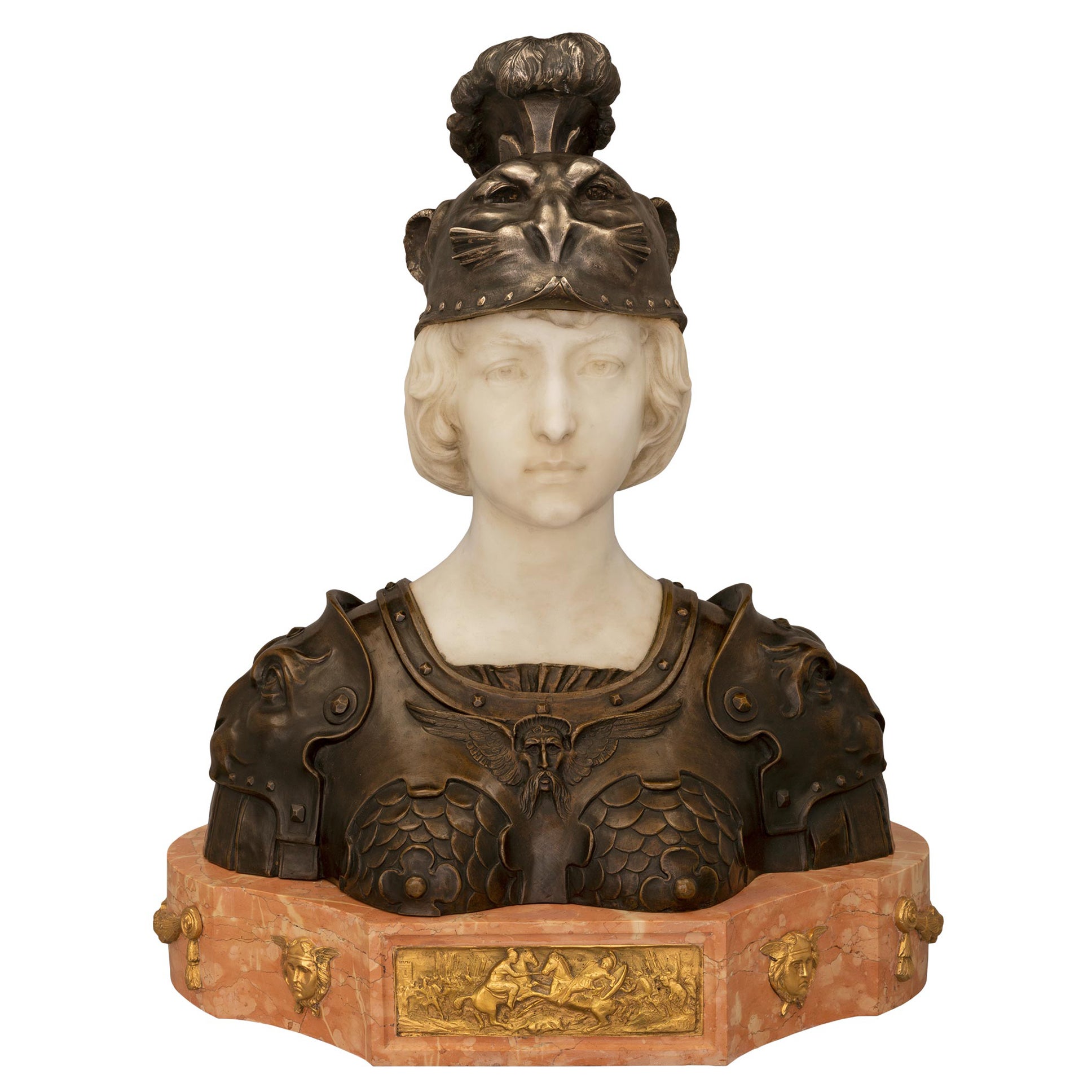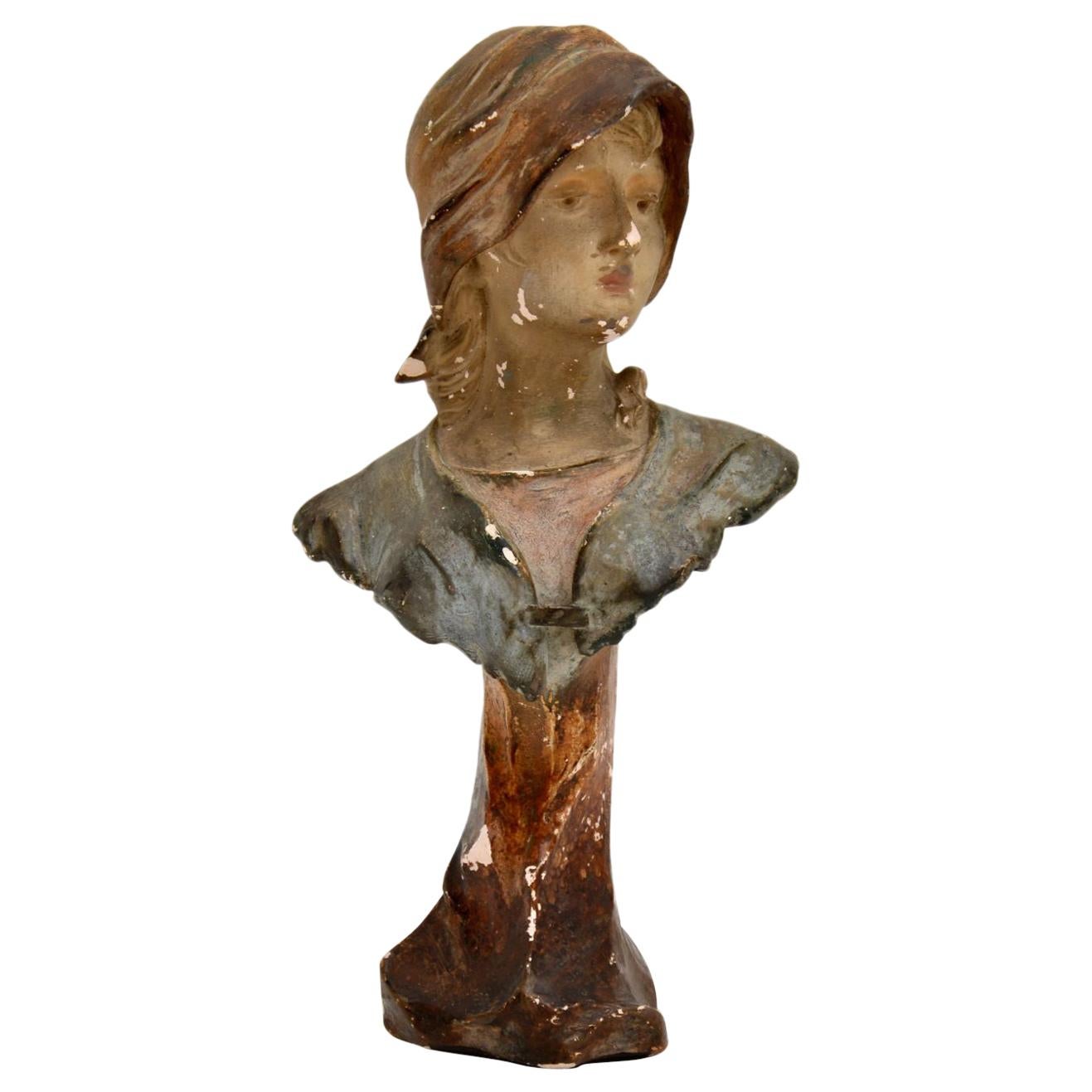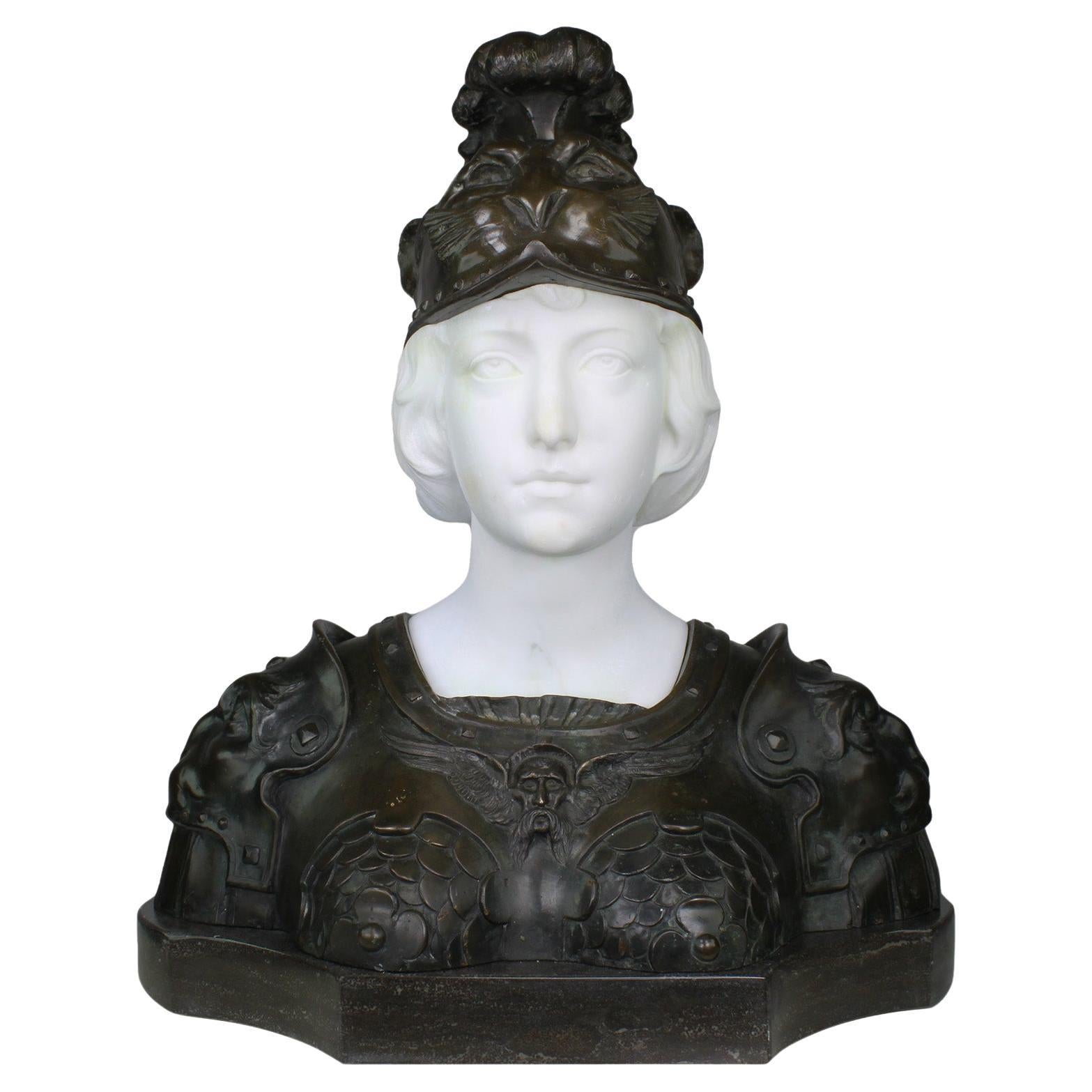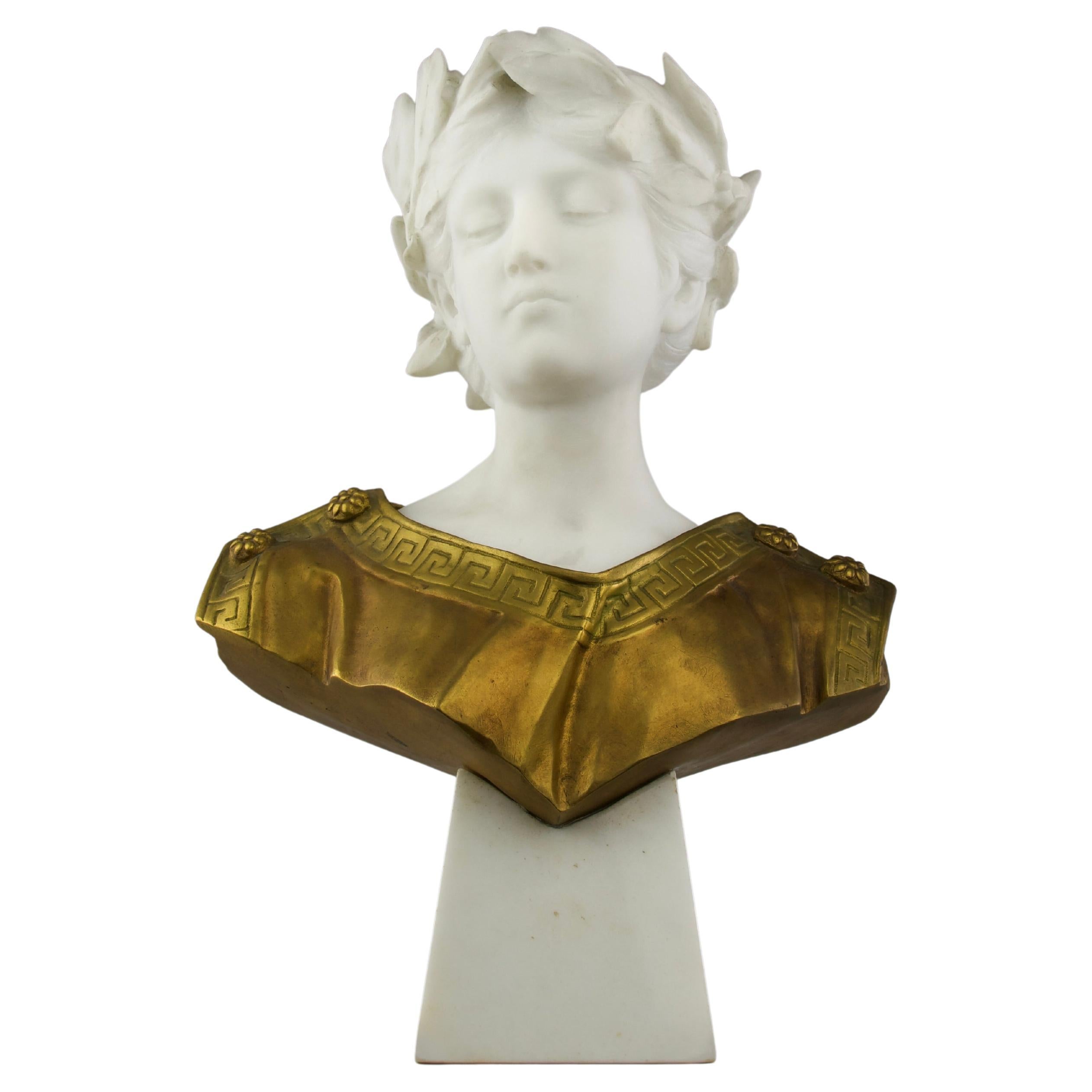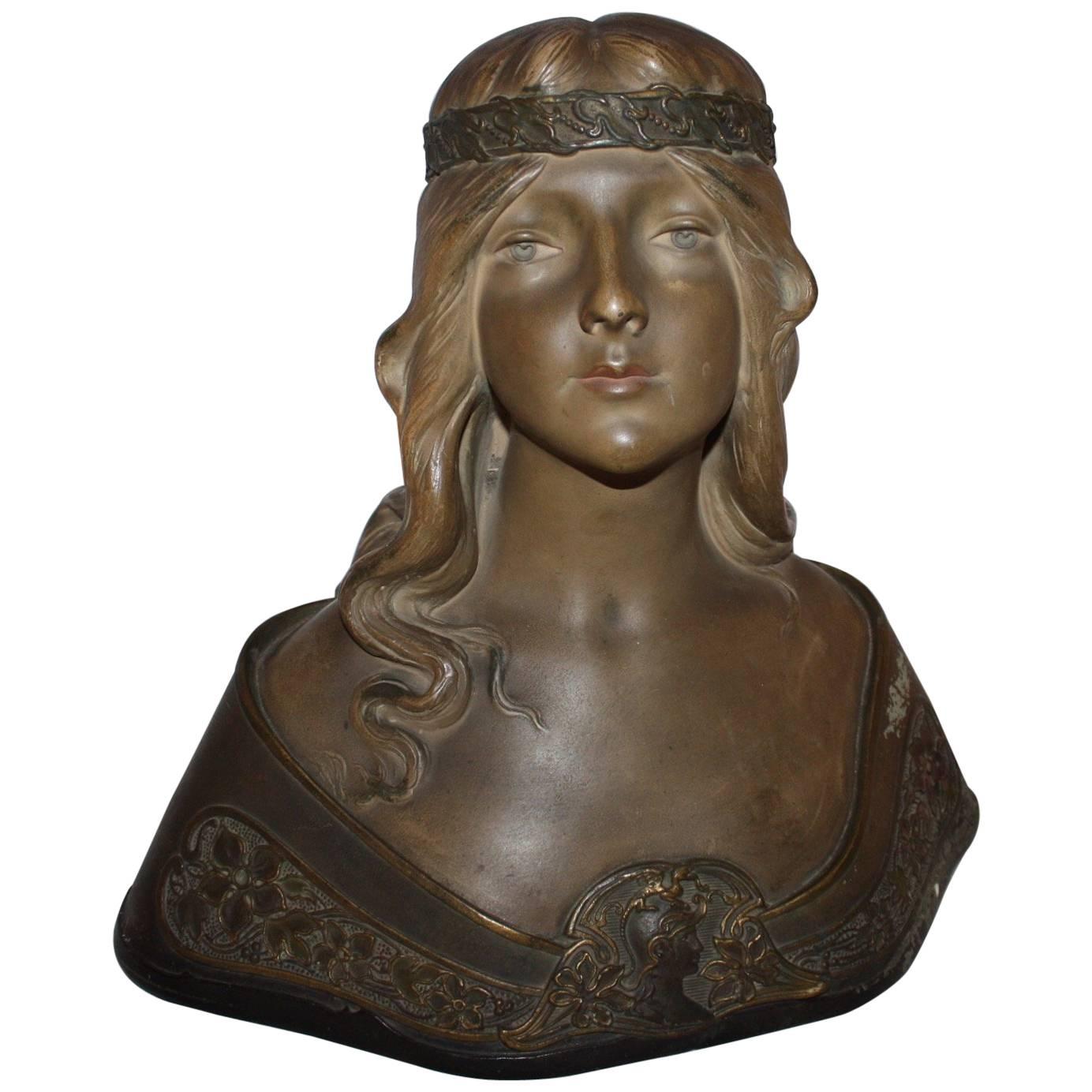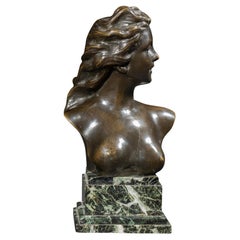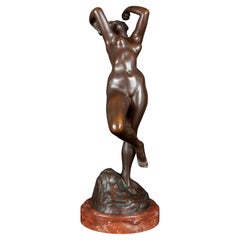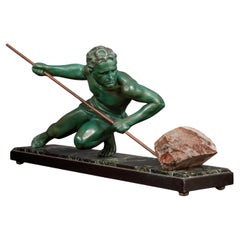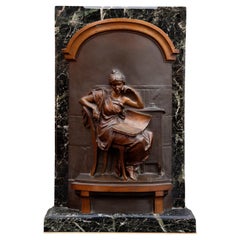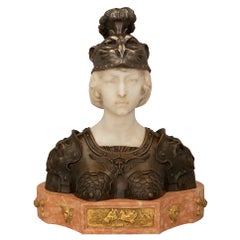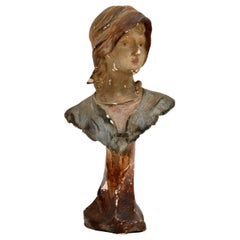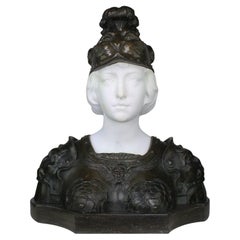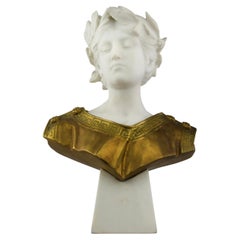Items Similar to GUSTAVE VAERENBERGH (1873-1927) Bust in Alabaster and Gilt Bronze "JEANNE D'ARC"
Want more images or videos?
Request additional images or videos from the seller
1 of 12
GUSTAVE VAERENBERGH (1873-1927) Bust in Alabaster and Gilt Bronze "JEANNE D'ARC"
$18,054.70
£13,134.59
€15,000
CA$24,639.48
A$27,438.28
CHF 14,280.11
MX$338,310.68
NOK 181,868.10
SEK 170,938.39
DKK 114,156.98
Shipping
Retrieving quote...The 1stDibs Promise:
Authenticity Guarantee,
Money-Back Guarantee,
24-Hour Cancellation
About the Item
GUSTAVE VAERENBERGH (1873-1927) Bust in Alabaster and Gilt Bronze "JEANNE D'ARC" (end 19th century-early 20th century)
- THE WORK:
The alabaster and gilt bronze bust of Joan of Arc by Gustave Van Vaerenbergh is a precise and delicate representation of the historical figure. The sculpture captures the nobility and determination of Joan of Arc with a downward-focused gaze. The fine details of the suggested armor enhance her aura of courage. The textures and expressions of the face are finely sculpted in alabaster, while the gilt bronze adds warmth and brilliance. This bust embodies the heroic spirit of Joan of Arc with sensitivity, blending alabaster and gilt bronze in an artistic mix.
- BIOGRAPHY OF THE ARTIST:
Gustave Van Vaerenbergh, a Belgian artist, studied at the Academy of Fine Arts in Ghent from 1888 to 1890. Coming from a modest background as the son of a shoemaker, he expressed his art in commercial enterprises. Settling in Schaerbeek in 1902, he became a sculptor at A. Carli Frères, specializing in commercial statues. Van Vaerenbergh is known for his busts of young women, statues of children, animals, and his chryselephantine sculptures in ivory, representing the Art Nouveau style.
- THE FOUNDRY:
The A. Carli Frères company, founded in the early 1900s in Schaerbeek, Belgium, by Antonio Carli, produced and published statuettes and sculptures in plaster, terracotta, marble, and bronze. Initially employing around 20 people and up to about 100 employees at its peak, it specialized particularly in religious and decorative sculptures. The works were reproduced in series with indicated serial numbers, reflecting prolific commercial activity. The varied sculptures, including those made by renowned artists like Gustave Van Vaerenbergh, often presented subtle variations in their reproduction, demonstrating the important commercial aspect of the company.
- Attributed to:Gustave van Vaerenbergh (Artist)
- Dimensions:Height: 32 in (81.28 cm)Width: 20 in (50.8 cm)Depth: 25 in (63.5 cm)
- Style:Art Nouveau (Of the Period)
- Materials and Techniques:
- Place of Origin:
- Period:
- Date of Manufacture:Inconnu
- Condition:Wear consistent with age and use.
- Seller Location:Ixelles, BE
- Reference Number:1stDibs: LU10116242324222
About the Seller
No Reviews Yet
Vetted Professional Seller
Every seller passes strict standards for authenticity and reliability
1stDibs seller since 2024
- ShippingRetrieving quote...Shipping from: Ixelles, Belgium
- Return Policy
Authenticity Guarantee
In the unlikely event there’s an issue with an item’s authenticity, contact us within 1 year for a full refund. DetailsMoney-Back Guarantee
If your item is not as described, is damaged in transit, or does not arrive, contact us within 7 days for a full refund. Details24-Hour Cancellation
You have a 24-hour grace period in which to reconsider your purchase, with no questions asked.Vetted Professional Sellers
Our world-class sellers must adhere to strict standards for service and quality, maintaining the integrity of our listings.Price-Match Guarantee
If you find that a seller listed the same item for a lower price elsewhere, we’ll match it.Trusted Global Delivery
Our best-in-class carrier network provides specialized shipping options worldwide, including custom delivery.More From This Seller
View AllJEF LAMBEAUX (1852-1908) "Bust of a Young Woman" in bronze
By Jef Lambeaux
Located in Ixelles, BE
JEF LAMBEAUX (1852-1908) "Bust of a Young Woman" in bronze.
Jef Lambeaux's "Bust of a Young Woman" with bared breasts is a striking work of art that embodies both beauty and controversy. Created by the eminent Belgian sculptor Jef Lambeaux (1852-1908), this bronze sculpture reveals exceptional technical mastery and extraordinary artistic sensitivity. The young woman depicted, with her hair flowing freely and her face imbued with serenity, embodies the quintessence of feminine beauty.
This work is part of the Romantic Realism...
Category
Antique Late 19th Century Belgian Art Nouveau Busts
Materials
Bronze
JEF LAMBEAUX (1852 – 1908) Bronze Statue "THE DANCER WITH CASTANETS"
By Jef Lambeaux
Located in Ixelles, BE
JEF LAMBEAUX (1852 – 1908) Bronze Statue "THE DANCER WITH CASTANETS" .
Imagine a sculpture that transcends mere representation to capture the very essence of movement and passion. "...
Category
Antique 19th Century Belgian Art Nouveau Figurative Sculptures
Materials
Bronze
Attributed to GUSTAVE LOUIS BUCHET (1888-1963) Bronze statue "L'EFFORT"
By Gustave Buchet
Located in Ixelles, BE
Attributed to GUSTAVE LOUIS BUCHET (1888-1963) Bronze statue "L'EFFORT" or "L'ATHLETE".
Description of the work The statue "L'EFFORT" or "THE MAN LIFTING A STONE" Attributed to Gust...
Category
20th Century Swiss Art Deco Figurative Sculptures
Materials
Bronze
Louis-Ernest Barrias (1841-1905) Bronze Bas-Relief "The Reader"
By Susse Freres, Louis Ernest Barrias
Located in Ixelles, BE
Louis-Ernest Barrias (1841-1905) Bronze Bas-Relief "The Reader".
Bas-Relief: "The Reader" is a bas-relief created by Louis-Ernest Barrias, a renowned 19th-century sculptor. The bas-...
Category
Antique 19th Century French Neoclassical Figurative Sculptures
Materials
Bronze
Jef Lambeaux (1852-1908) “THE SOWER”
By Jef Lambeaux
Located in Ixelles, BE
Jef Lambeaux (1852-1908) “THE SOWER”
Artistic Description:
"The Sower" depicts a vigorous young man, bare-chested, in the act of sowing seeds. The sculpture captures with precision...
Category
Antique Late 19th Century Belgian Art Nouveau Figurative Sculptures
Materials
Bronze
Emile Louis Picault (1833-1915) « LE TRAVAIL » bronze statue
By Émile Louis Picault
Located in Ixelles, BE
Emile Louis Picault (1833-1915) « LE TRAVAIL » bronze statue
The bronze statue 'Le Travail' by Émile Louis Picault is much more than a mere work of art. It embodies the very essence...
Category
Antique 19th Century French Industrial Figurative Sculptures
Materials
Bronze
You May Also Like
French 19th Century Neo-Classical St. Bronze, Marble, & Ormolu Bust of Marianne
Located in West Palm Beach, FL
A stunning and most impressive French 19th century Neo-Classical st. patinated bronze, silvered bronze, ormolu, Rosso Verona and white Carrara marble bust of Marianne in full armor. The bust is raised by a thick Rosso Verona marble base with an elegant scalloped shape adorned with richly chased masks and swaging berried laurel garlands and centered by a striking fitted ormolu plaque...
Category
Antique 19th Century French Neoclassical Busts
Materials
Marble, Bronze, Ormolu
Antique Art Nouveau Plaster Bust by Hochock
Located in London, GB
A stunning antique bust from the Art Nouveau period. We think this is French and dates from around the 1890-1900 period.
It depicts a young girl in a shawl, it is signed and numbe...
Category
Antique Late 19th Century French Art Nouveau Busts
Materials
Plaster
French 19th Century Bronze and White Marble Bust of Marianne in Full Armor
Located in Los Angeles, CA
A French 19th century bronze and marble bust of Marianne in full armor. The nicely cast Baroque Revival brown patinated bronze and carved white marble figure of Marianne, the allegorical personification of the French Republic, presented in her militaristic guise, reminiscent of Minerva, wearing a Phrygian helmet and armored breastplate centered by winged male mask and with lion shoulder armor pads, all raised on a conforming black marble base. Circa: 1890-1900.
Marianne has been the national personification of the French Republic since the French Revolution, as a personification of liberty, equality, fraternity and reason, as well as a portrayal of the Goddess of Liberty.
Marianne is displayed in many places in France and holds a place of honor in town halls and law courts. She is depicted in the Triumph of the Republic, a bronze sculpture overlooking the Place de la Nation in Paris, as well as represented with another Parisian statue on the Place de la République. Her profile stands out on the official government logo of the country, appears on French euro coins and on French postage stamps. She was also featured on the former franc currency and is officially used on most government documents.
Marianne is a significant republican symbol; her French monarchist equivalent is often Joan of Arc. As a national icon Marianne represents opposition to monarchy and the championship of freedom and democracy against all forms of oppression. Other national symbols of Republican France include the tricolor flag, the national motto Liberté, Égalité, Fraternité, the national anthem "La Marseillaise", the coat of arms, and the official Great Seal of France. Marianne also wore a Cockade and a red Phrygian cap symbolizing Liberty.
Minerva and its pendant bust of Mars evoke the classicizing subjects, bust-length formats, and style that originated in France during the reign of Louis XIV (1643–1715) and that concurrently was popularized across Europe. The busts' simple forms, stiff poses, and solemn facial types are consistent with the late Baroque sculptures that were carved in Flanders during this period. In Flanders, especially in Antwerp and Brussels, sculpture and architectural decoration traditionally was carved using combinations of native black marble (noir belge), mottled red marble (rouge belge), and white marble or alabaster. The use of these stones in colorful counterpoint speaks most strongly to the busts’ Flemish origins.
The veneration of ideal heroes and heroines in ancient costume and arms took on extravagant form in the 17th century, with countless variations. Within this imaginative tradition, the identification of the pair as Minerva and Mars cannot be certain. The female bust, for example, could be identified as Bellona, Roman goddess of war, who is depicted in 17th and 18th century French paintings wearing flamboyantly plumed helmets and low-cut cuirasses that expose her breasts. Whatever their identities, the female and male warriors are portrayed as calm rather than bellicose beings. The sovereign pair does...
Category
Antique 19th Century French Baroque Revival Figurative Sculptures
Materials
Marble, Bronze
$24,950 Sale Price
27% Off
Attilio Fagioli, Young Emperor Bust Sculpture, Italy Early 20th Century
By Attilio Fagioli
Located in PARIS, FR
Superb marble and gilt bronze bust representing a young emperor with his robe and laurel wreath. Italy early 20th century, of the Romantic style.
Signed A. Fagioli.
Dimensions in ...
Category
Early 20th Century Italian Romantic Busts
Materials
Marble, Bronze
Antique Art Nouveau Female Carrara Marble Gilt Bronze Bust Statue Sculpture 1900
Located in Portland, OR
A very beautiful antique Art Nouveau bronzed Carrara marble sculpture bust of a young maiden circa 1900, by Gustave Van Vaerenbergh (1871-1927).
The sculpture portrays a beautiful young maiden made from Cararra marble, she is wearing a laurel wreath in her hair. She wears a bronzed bodice with leaf decoration in relief and is raised on a varigated grey & white socle base. The sculpture is signed to the rear " G. V. Vaerenbergh" and numbered "1173", the bust is in excellent condition.
Gustave Van Vaerenbergh attended classes at the Academy of Fine Arts in Ghent, Belgium from 1888 to 1890. Like many artists from a modest background (he was the son of a shoemaker) , Gustave Van Vaerenbergh went to work in companies where he could use his artistic talent and education for commercial purposes.
In 1901 he moved to Saint-Josse-ten-Noode , and a year later to Schaerbeek where he would live for the rest of his life. He went to work there as a " mouleur en plâtre " (modeller or maker of matrices for plaster statues) at the company A. Carli Frères in the L'Olivierstraat in Schaerbeek, a company that produced commercial statues. This successful company, which was active from the beginning to the middle of the twentieth century , initially had about 20 employees and at its peak about 100 employees. The statues were distributed worldwide. Antonio Carli, a sculptor, was the founder of the Atelier A. Carli Frères, together with family members. They came from Bagni di Lucca...
Category
Early 1900s Art Nouveau Figurative Sculptures
Materials
Marble
Magnificent 19th Century French Bust
Located in Stockbridge, GA
Magnificent 19th century French bust, signed and dated.
Category
Antique Late 19th Century French Louis Philippe Busts
Materials
Terracotta
More Ways To Browse
Art Nouveau Numbers
Alabaster Statues
Statues Of Women
Antique Joan Of Arc
Art Nouveau Plaster Sculpture
Joan Of Arc Sculpture
Art Nouveau Alabaster Sculpture
Cocktail Glasses Red
English Jug
Floating Lamp
Hoof Feet Table
Lyre Dining
Marble Large Vase
Marble Tables From China
Midcentury Ceramic And Wood Lamp
Midcentury Modern Wood Wall Sconce
Neoclassical Light Chandelier
Pacific Northwest Rug
